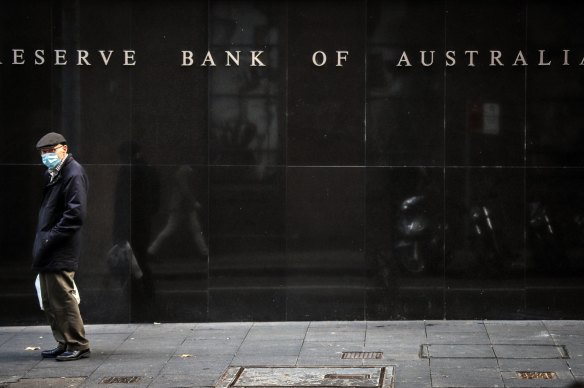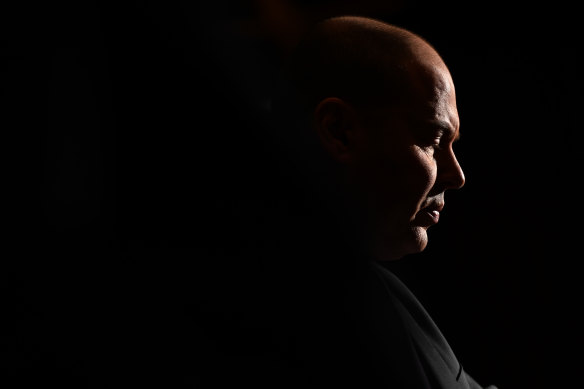This was published 9 months ago
The half trillion-dollar stimulus we didn’t know about
By Shane Wright
It’s the half a trillion dollar stimulus most Australians did not know existed.
But a series of reviews by the Reserve Bank into its own policies now confirm the extraordinary quantum of support it used to protect Australia from a deep and enduring Covid recession.

The Reserve Bank has looked at its key Covid-era policies to determine what worked and what didn’t. Australian governments have yet to do so.Credit: Bloomberg
The same reviews reveal problems with the bank’s exceptional policies that damaged its reputation, left it with huge losses that will prevent it paying dividends back to taxpayers for years and helped fuel the biggest increase in house prices in a generation.
And there is one outstanding question: did the combination of $500 billion in stimulus from the RBA, on top of record low-interest rates and government assistance, contribute to the inflation problem that forced the bank into aggressive interest rate increases?
Last week, the Reserve released its report into its $188 billion lifeline of cheap money to commercial banks. It was the fourth review by the bank to garner an understanding of what worked – and what didn’t – through the pandemic.
The $188 billion, and other measures, were put in place amid fears of a crash like the Great Depression, which some economists believed could include15 per cent unemployment.
While the Reserve Bank’s most obvious mechanism to deal with the economy is official interest rates, during Covid it embarked on so-called ‘quantitative easing’ measures. These parts of a central bank’s toolkit, never before used by the RBA, have been the subject of its four internal reviews.
One tool was forward guidance, in which the bank indicated where interest rates were likely to head. Then-governor Philip Lowe’s 2021 statement that interest rates were unlikely to lift until 2024 was the most obvious example.
But the bank went much further. The largest measure was the $281 billion the RBA spent buying up federal government and state debt to drive down their borrowing costs.
In October 2019, before the pandemic, the bank held just $9.6 billion worth of government debt. About $7.4 billion of that was federal debt.
But by April 2022, the bank owned almost $356 billion of government debt including $288 billion of federal debt, $17 billion of NSW debt and $15 billion of Victorian debt.
Some of this debt was accrued by the Reserve as it targeted the interest rate on federal government 3 year bonds. This debt, considered vital to anchoring all other government debt interest rates, was a program the RBA termed its “yield target”.
Another $188 billion program, called the term funding facility, delivered ultra-cheap cash in short-term loans to 92 banks, including the nation’s big four, to support the economy and particularly small businesses.
Together, these programs were worth $469 billion. That doesn’t include the financial boost, worth tens of billions of dollars, delivered by the cut in official interest rates which fell by 0.65 percentage points in 2020 and held at 0.1 per cent until May 2020.

Josh Frydenberg announces key elements of the government’s Covid response in 2020. Credit: Sam Mooy/Getty Images
The bank’s four reviews all argue the schemes worked. That can be measured in the way the Australian economy quickly emerged from pandemic and the extraordinary strength of the jobs market.
Unemployment hit 7.5 per cent in July 2020. A year later, it was 4.8 per cent which was lower than it had been before the pandemic. It would ultimately fall to a 50-year low of 3.5 per cent while the share of Australians in work is at an all-time high.
But each review has revealed problems.
The forward guidance review confirmed the troubles the bank created for itself with Lowe’s commentary around a date, rather than saying a lift in rates would depend on the state of the economy.
Borrowers heard 2024, getting a huge shock when the bank started increasing rates in 2022.
“The RBA attracted extensive criticism when the cash rate was increased much earlier than implied by the conditional time-based guidance,” that review found.
So gun shy has the bank become over this issue, Michele Bullock now goes out of her way to say she is not giving forward guidance when talking about future interest rate movements.
The $288 billion purchases of government debt worked as planned to bring down interest rates. But because the economy rebounded, and interest rates increased to deal with inflation, the RBA has found itself with huge losses.
In 2021-22, the Reserve suffered an accounting loss of $36.7 billion. No bank or private business has ever come close to such a loss in Australia. It means the RBA cannot pay a dividend to the federal government and federal taxpayers.
The final bill will not to be known until 2033 when the debt is repaid.
The bank admitted its yield target policy had caused the RBA “reputational damage” because of “bond market volatility and some dislocation in the market” when the scheme was coming to an end.
Last week’s review argued a term funding facility should be used again in the future if the economic circumstances require it.
But the review also found the bank had lost about $9 billion and conceded that instead of the cash boosting small businesses it had flowed into housing.
There, like some expensive cocktail, it swirled with low interest rates, government handouts to first time home buyers, household savings engorged by government stimulus payments and Australians who wanted properties with extra rooms for their home offices to deliver the biggest increase in house prices in a generation.
The common theme across all the reviews is that the bank, naturally, feared the worst for the economy.
“In retrospect, a greater focus also on upside risks could have led to a different calibration of the scheme,” its report into the term facility noted.
What’s missing is an analysis of two things: the ultimate cost of the “extra” stimulus in terms of inflation, and how all of it interacted with government spending.
At least the RBA has been upfront with its self-reflection. It’s a different story at the government level.
Treasury conducted an early examination of the $90 billion JobKeeper (which gave it a clean bill of health) while a federal inquiry, which includes respected economist Angela Jackson, is close to releasing a report into broad elements of the Covid response.
But the Morrison government did far, far more than JobKeeper.
Its $38 billion superannuation withdrawal program was Covid’s second-largest government stimulus measure. The only examination of this, done by economists Steven Hamilton, Tristram Sainsbury and Geoffrey Liu, revealed people rushed to drain their retirement savings with gambling one of the major beneficiaries.
The cost to those using the scheme has been estimated at $120,000 in forgone retirement savings, which a future government will have to cover.
No one has dared look at the $35 billion cash-flow boost to businesses that gave firms up to $100,000, no questions asked. An auditor-general review has revealed HomeBuilder, a $700 million program aimed at supporting house construction, blew out to $2.7 billion and is one of the reasons for the inflation that has plagued the building sector.
And the $5.8 billion Boosting Apprenticeship Commencements program, promised to drive a surge in apprenticeships post-pandemic, ended up being used by firms such as Grill’d and McDonald’s to pump young people through low level programs that the companies were never going to end. They simply substituted their own cash for taxpayers’ cash.
Treasurer Jim Chalmers, pressed last week on whether he would follow the RBA’s lead by looking at the dirty laundry in coronavirus-era policies, demurred.
“I haven’t commissioned further advice on other elements of the previous government’s response,” he said.
“We have paid down about $150 billion of debt, including a lot of that debt that was racked up during Covid, and so that’s been our focus rather than on going through some of the specific elements of it.”
Cut through the noise of federal politics with news, views and expert analysis. Subscribers can sign up to our weekly Inside Politics newsletter.